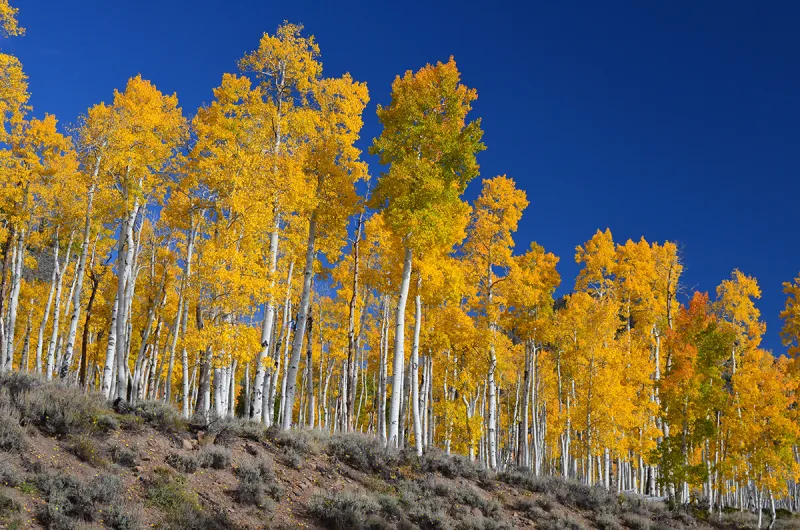Pando

Massive clonal colony of quaking aspen trees, covering over 100 acres and considered one of the largest and oldest living organisms on Earth..
Place overview
Pando (from Latin pando 'I spread') is the name of a quaking aspen (Populus tremuloides) clone located in Sevier County, Utah, United States, in the Fishlake National Forest. A male clonal organism, Pando has an estimated 47,000 stems (ramets) that appear to be individual trees but are not, because those stems are connected by a root system that spans 42.8 ha (106 acres). As a multi-stem tree, Pando is the world's largest tree by weight and landmass. Pando was identified as a single living organism because each of its stems possesses identical genetic markers. The massive interconnected root system coordinates energy production, defense and regeneration across the tree's landmass. Pando spans 1.08 km × 0.72 km (0.67 mi × 0.45 mi) at its widest expanse along of the southwestern edge of the Fishlake Basin. It lies 0.69 km (0.43 mi) to the west of Fish Lake, the largest natural mountain freshwater lake in Utah. Pando's landmass spreads from 2,700 m (8,900 ft) above sea level to approximately 2,773 m (9,098 ft) above sea level along the western side of a steep basin wall. Pando is estimated to weigh collectively 6,000 tonnes (6,000,000 kg), or 13.2 million pounds, making it the heaviest tree of any kind. The Pando Tree's 43-hectare (106-acre) expanse also makes Pando the largest tree of any kind by way of landmass.
Systems of classification used to define large trees vary considerably, leading to some confusion about Pando's status. Within the United States, the Official Register of Champion Trees defines the largest trees in a species-specific way; in this case, Pando is the largest aspen tree (Populus tremuloides). In forestry, the largest trees are measured by the greatest volume of a single stem, regardless of species. In that case, the General Sherman Tree is the largest unitary (single-stem) tree. While many emphasize that Pando is the largest clonal organism, other large trees, including Redwoods can also reproduce via cloning. Pando being the heaviest tree and the largest tree by landmass, while also being the largest aspen clone, leaves the Pando Tree in a class of its own.
Since the early 2000s, little information has been adequately corroborated about Pando's origins and how its genetic integrity has been sustained over a long period of time, conservatively between 9,000 and 16,000 years old-by the latest (2024) estimate. Researchers have argued that Pando's future is uncertain due to a combination of factors including drought, cattle grazing, and fire suppression. In terms of drought, Pando's long lived nature suggests it has survived droughts that have driven out human societies for centuries at a time. In terms of grazing, a majority of Pando's land mass is fenced for permanent protection and management as a unique tree. Cattle grazing ended in Pando in 2024, but previously, was permitted on a volume basis for 10 days a year in October, weather permitting, in a small edge of Pando's southeastern expanse. Additionally, between 2015 and 2022, local grazers group, 7-Mile Grazers Association who rely Pando's forage and biomass to sustain the landscape, signed off on a long term protection plan working with Fishlake National Forest and Friends of Pando, and also wrote letters of support for the "Pando Protection Plan". which would bring nearly 34 hectares (84 acres) of the tree into protective care. In terms of fire suppression, research indicates Pando has survived fires that would have likely leveled the tree many times, after which Pando regenerated itself from the root system. The same research also indicates large-scale fire events are infrequent, which may be owed to the fact that aspen are water-heavy trees and thus, naturally fire resistant, earning them the name "asbestos forests" among wildfire scientists. There is broad consensus that wildlife controls to protect growth from deer and elk are critical to Pando's sustainability and care. Protection systems coupled with ongoing monitoring and restoration efforts have been shown to be the most effective way to care of the tree dating back to the late 1980s and early 1990s, with new projects under way.
Learn more about PandoView places in the same country
Gallery
View the source gallery here: Pando Wikimedia
